
|
The Liquefied Petroleum
Gas shipping market
in 2004
Out of the doldrums
to a sharp and sustained recovery
|
Significant events
Situation by ship size:
- VLGC
- LGC
- Mid-size
- 8 000/22 000 cbm
- 8 000 cbm and less
Prospects
The second-hand market
|
|
Significant
events |
|
|
At the same time last year, we drew a comparison
between the different shipping markets with the
take-off of the oil and bulk sectors compared to
the depressed state of the LPG sector over the
recent years, marking a significant break in the
respective evolution of these markets.
We also evoked the main readjustments, which
were already taking place, susceptible of causing
a reversal of this trend and bringing about a
revival in this specialised shipping segment.
All these factors became more pronounced
throughout the course of 2004 and gave rise as
from May / June to a sharp jump in freight rates,
for all sizes, both on the spot as well as on time
charter market.
The main evolutions, of which some have been in
evidence for several years, can be described as
follows:
- Joint-ventures and pool agreements between
owners and ship operators, leading to an
optimisation of operations and a higher
specialisation by groups of operators within the
various categories of ship sizes and specific
trade routes.
- The cross-purchases of ships, or even whole
fleets, within the smaller sizes.
- A slow-down in newbuilding orders over the
last few years, given the poor returns on
investments in the gas shipping sector. Even if we
have seen a correction during the last six months
within the liquefied gas sector, shipyards'
orderbooks are now sufficiently filled-up with
orders of other ship types from sectors which have
been riding high over the last two to three years
(LNG, bulk carriers, and tankers). As of now, the
lack slots availability in the yards does not
allow any further deliveries before end 2007 /
beginning 2008, thus not before another three
years!
- Demolition remained at the same limited pace
as last year but with even higher values given the
price of steel. The hurdle of $ 400 per
lightweight ton has been surpassed, putting the
value of a 75,000 cbm VLGC of 25 years or more at
nearly $8 million apiece! Since the beginning of
the year some 19 units have been sold for
demolition for a total capacity of nearly half a
million cbm.
- A sustained surge of imports to North America
linked to the constant appreciation of natural gas
price which have reached a level near to $ 8 per
mmbtu last November.
- An expansion in LPG and ammonia production
and the long-awaited revival in petrochemicals,
after the depression of the last few years, linked
to an increase in deep-sea trade affecting voyage
lengths and demand expressed in tonne-miles.
- A burst of imports into developing countries,
such as China with its enormous population, making
it susceptible to an impressive growth of such
magnitude that it should spill over in the short
and medium terms to a redistribution of major
trades and economic movements in the world.
- A depreciation of the dollar against other
currencies, resulting in the necessity to give
more dollars for the same front values.
Most of these trends have been building up over
some time, but the year 2004 saw the confirmation
of these expectations at such an accelerated
rhythm that even the most astute forecasters have
been confounded.
We shall not dwell in detail on the reasons for
such a market correction, largely anticipated, but
rather on the extent of this new situation and the
consequences that might develop from such a change
in situation.
***
In line with the freight market, which saw a
steady rise but more pronounced as from the third
quarter, product prices also underwent a very
strong appreciation right throughout the year.
This increase gathered pace particularly in the
second half, with highly volatile variations which
allowed arbitrage movements between East and West.
The threshold of $ 500/t was crossed at the end of
the year for LPG C&F sales into the Far East!
Our annual table showing the evolution of price
levels for the main oil and gas related products
over the last three years shows:
|
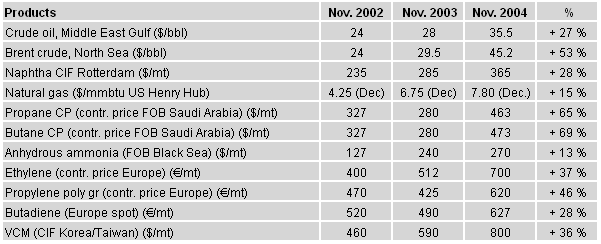
|
|
Shipping and freight levels in all sizes saw a
marked increase as from the middle of the year and
especially towards the end of the year.
We would point out that these average freight
rates (in time charter equivalent of spot voyages)
exclude any eventual ship's idle time (awaiting
employment between voyages) and are neither
representative of net profit for owners operating
their ships on the spot market, nor of the long
term transactions (two years or more).
|

|
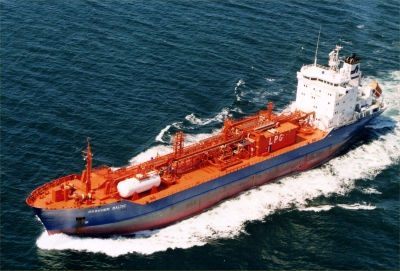
|
Gaschem Baltic
8,600 cbm, built in 2004 by Severnav, operated by
Gaschem |
|
|
Situation by vessel size |
|
|
|
|
|
|
|
A strong variation in spot freight rates characterised the
first half of the year, leading to tighter and more stable
levels in the second half.
Starting around $ 30/t on the Middle East / Japan route
at the beginning of the year, rates went over $ 40/t and
then approached $ 48/t in October, with a critical peak
period between June and September. A slight easing was felt
as from November, but the level remained slightly above $
40/t at the end of December. These spot rates represent
equivalent monthly time charter rates between $ 700,000 and
$ 1,200,000 with a year average of about $ 850,000.
|
|
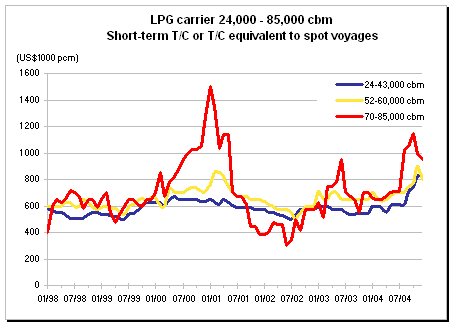
|
|
The firmness of the naphtha market was again a determining
factor throughout the whole year, with the returns on
naphtha voyages substantially surpassing those of an LPG
equivalent, thus providing 6 to 10 VLGCs being employed in
this market.
Four units from the 1970's were scrapped at twice the
price levels of the preceding year, thanks to steel prices
remaining high.
13 new orders were registered during the year for
delivery between end 2006 and 2008 at prices over $ 70
million for the latter orders.
The entry of AP Moller into this sector was signalled
with their order of four 82,000 cbm in Korea for delivery in
2007 and their subsequent commitment for a three-year
charter of the VLCG 'Oriental Queen' -82,000 cbm- delivered
to Unique Shipping in September 2004.
Market prospects in this size category remain positive
for several years to come, but we cannot avoid to signal the
risk of seeing again an imbalance, if the pace of new orders
were to intensify or even to remain steady at the same rate
as the last few months.
The big jump in newbuilding costs and the late delivery
dates might however limit such a development or at least
give rise to some reconsideration of market assessments.
|
|
|
|
|
This segment size which had already fared well last year,
improved strongly throughout 2004 to reach occasionally
monthly time charter rates of nearly one million dollars on
some voyages, with the average being around $ 800,000 per
month.
These units, mainly employed on the major ammonia and LPG
trade movements, benefited from the strong revival of
exports of these two products to North America: ammonia due
to the steady and sharp rise in the price of natural gas,
from which it is derived, with a consequent drop in local
production, and butane / propane due to the arbitrage which
the price fluctuations within Europe, the Middle East and
the US allowed.
Four newbuildings of 59,000 cbm were delivered
respectively for Sonatrach, Solvang, and Yara, whilst two
more are due to be delivered to Sonatrach and Yara in the
course of 2005.
Bergesen sold two 53,000 cbm units, built in 1973 and
1979, for demolition.
Whereas the delivery of 10 newbuildings spread out
between 2003 and 2005 might have led one to expect an
occasional marginal overcapacity, it seems that the
scrapping of the older units combined with the recent
recovery of the market has allowed for a good balance, and
even a slight improvement in the demand for these ships. All
of this was supported by the firmness in the VLGC market and
the contribution from the naphtha market.
|
|
|
|
|
A good vintage for this category of vessel confirming
earlier expectations, with a steady progress and
satisfactory results for owners.
It is nonetheless worth underlining that the consequences
of the market's recovery as from the summer was less obvious
in this size segment than in the others. A particularity we
can attribute to the fact that this category had already
registered far better results comparatively to the others
since several years.
From a level of around $ 575,000 in November 2003, the
monthly time charter rate (equivalent t/c for spot voyages
or short period t/c) for 24,000 to 35,000 cbm ships averaged
at around $ 775 000 in 2004.
The main ammonia trade routes are highly demanding this
type of ship with a solid growth in transatlantic movements,
as well as the Black Sea and the Middle East Gulf to Indian
Ocean and inter Asia.
With only 30 %, the share of LPG in this segment is
declining. The average idle time due to non-employment in
this sector is now below 6 % whereas it was still over 14 %
in 2003.
Contrary to what we expected last year, the stability of
the market during the last few years and increased
production forecasts, have triggered a mini-explosion in new
orders for ships with a 35,000 to 38,000 cbm capacity for
delivery between 2006 and 2007 (for account of K Line,
Zodiac, Iino, Unique/Itochu, Bakri, and Sovcomflot). These
eleven orders came on top of five 38,500 cbm ships ordered
since last year for delivery in 2005 and
2006, which makes a total of 16 units coming into service
between end 2005 and 2007.
It should be noted that the last 35,000 cbm ships were
ordered at over $ 50 million per unit, whereas the previous
orders inked in 2003 were done at just over $ 40 million,
thus representing an increase of 20 %. One should however
remember that the depreciation of the dollar since September
2003 has been of around 20 %, a detail which should not be
ignored in analysing price rise or increase in freight
rates.
|
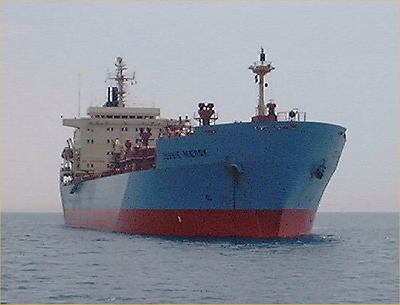
|
Jessie Maersk
35,559 cbm, built 1991 by Hyundai H.I., owned by
A.P. Moller |
|
|
|
|
| Among all the size
segments, this category has been the first to benefit from
the market revival. The chemical gas sector, and more
particularly ethylene and propylene, were the principal
driving force of this recovery. There were a few promising
indications at the end of 2003 which were confirmed and then
helped transform and amplify this trend as from July.
Most ethylene carriers which previously were forced to
find alternative employment in LPG returned to their normal
trade where the deepsea voyages have multiplied, giving a
substantial increase in demand expressed in tonne-miles.
We have seen a lively recovery in exports of ethylene and
propylene out of the US into Europe and Asia, an increase in
movements from the Middle East to Asia and more arbitrage
positions being taken out of Europe to Asia. Additional
movements from Asia to Europe have been motivated by the
pressure on product prices resulting from shutdowns of
crackers, planned or not, within the different geographical
areas.
All these simultaneous movements created a tremendous
pressure on demand, causing spot freight rates to hit levels
never seen before, with increases of up to 70 %.
- about $ 300/t for propylene lots of 6,000 to 8,000 mt
from the U.S. to Asia
- up to $ 180/t for ethylene in 2,000
to 4,000 mt lots from the U.S. to Europe
- up to $ 250/t for
ethylene in 4,000 to 5,000 mt lots from S.E. Asia to Europe
- about $ 350/t for butadiene in 3,000 to 4,000 mt lots from
Europe to Asia.
Most charters were renewed for 2005 at levels ranging
from 30 to 50 %, depending on the size and trading
route. Some owners or operators had to refuse taking on new
contracts due to a lack of potential tonnage. A first for
several years!
At the same time, the LPG activity was equally well
supported by the arbitrage movements between Europe and the
U.S. caused by the huge volatility of LPG prices in turn
affected by the variations in oil prices.
Time charters were also greatly influenced by the
market's recovery as from the middle of the summer and the
majority of renewals for period business saw somewhat less
pronounced increases ranging between 25 to 30 %.
On the newbuilding front, two orders of 22,000 cbm
semi-ref were signed by Sonatrach/Hyproc with Namura for
delivery in 2007/2008, two 16,000 cbm ethylene carriers
were ordered by the Taiwanese Formosa Plastics with Jiangnan
in China for delivery in 2006, whilst Lauritzen Kosan
decided at the end of the year to order four 8,000 cbm
ethylene carriers with INP in Korea for delivery in 2007.
A vessel of 15,000 cbm built in 1976 was sold for scrap
at the beginning of 2004.
In the same period, Sigloo (with a majority control by
Camillo Eitzen) purchased seven 8,000 to 12,000 cbm ethylene
carriers built in the 1980's, which Bergesen was looking to
dispose of for quite some time, for a total value of around
$ 75 million.
Given the general optimism prevalent in the petrochemical
sector (new productions, increase in consumption and demand
in Asia) and the little addition of newbuildings tonnage
over the next two to three years, the market for this size
sector should remain very sustained in the coming years.
|
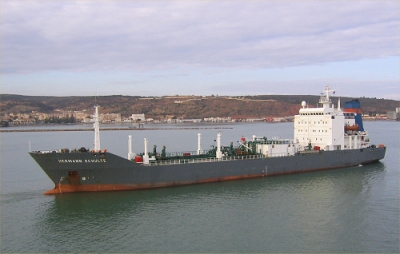
|
Hermann Schulte
5,673 cbm, built in 1980 by Meyer Werft, operated
by Dorchester Marine |
|
|
|
|
Same causes, same results! Except that the market level for
this size range was extremely weak over the previous two to
three years, so that the recovery has been even more
significant, compared to the other segment.
The increase in demand was felt right at the start of the
year and then gradually developed during the first half. It
was even more noticeable in the second half, both for
semi-pressurised as well as pressurised ships.
|
|
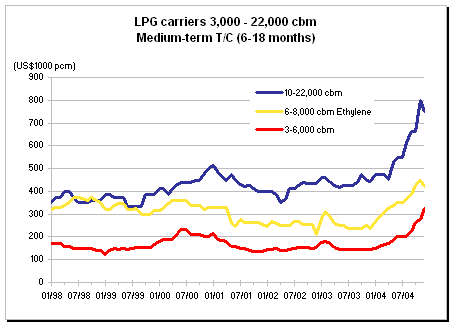
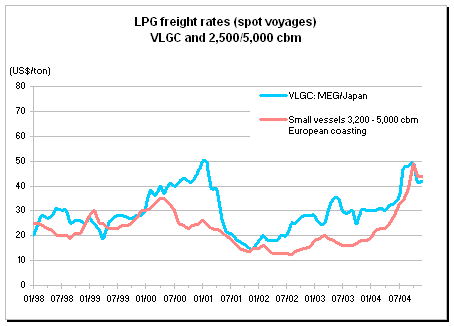
|
|
A 3,500 cbm pressurised carrier was being traded at an
equivalent time charter monthly rate of $ 130,000 to $
140,000 at the beginning of the year, whereas the same
vessel was trading at a level of $ 250,000 to $ 275,000 at
the end of the year.
A 6,000 cbm semi-refigerated vessel would fetch in the
same periods a level of $ 250,000 rising up to nearly $
450,000 monthly t/c or equivalent spot rate, with an even
more pronounced variation for ethylene carriers where a
6,000 cbm rose from $ 275,000 up to $ 550,000.
It should also be noted that there has been a correction
in the traditional differentials between the levels of
semi-refrigerated and pressurised carriers, with the latter
catching up and nearly obtaining the same returns as the
former. Another sign of the market's tendency!
As far as the time charter business is concerned, several
contracts spanning up to 5 years, were principally
undertaken by some owners-traders deciding to fix their
position for the future.
A substantial rise in new orders, in particular for
pressurised vessels between 3,500 and 9,000 cbm, was
registered with Japanese shipyards for domestic
owners-operators' account, placing these new units under
long term contracts with Eastern and Western majors. We have
counted currently some fifteen orders placed in 2004 for
ships with a capacity between 3,500 and 9,000 cbm, of which
two 8,600 cbm semi-refrigerated, for delivery between 2006
and 2008, as well as new orders which should be confirmed
imminently for units of 4,000 to 9,000 cbm in Italy.
These past twelve months have also witnessed new merger
transactions and fleet purchases between owners, which were
anticipated for several years given the poor levels of past
results'
During the second quarter, the Exmar Kosan pool took
control of 12 pressurised carriers of 3,500 to 5,000 cbm
from Far East Shipping, thus taking an additional grip on
this inter Asian market. Several months later five 3,000 to
6,500 cbm semi-refrigerated carriers of Gibson Gas Tankers
were acquired by Camillo Eitzen.
A Greek owner, Stealth Maritime, already well established
in other types of ships, made a noteworthy entry into the
gas sector with the acquisition of some ten small gas
carriers of 3,000 to 5,000 cbm at prices well above those
obtained last year.
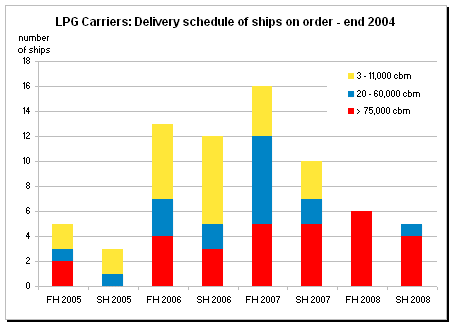
|
|
Prospects |
|
| Conditions for a very
firm freight market seem to be in place for the next few
years. Although it was already fairly clear, all the
ingredients are now solidly anchored for the trend to pursue
in the same direction.
Arrival of new tonnage over the next two years remains
very limited and will probably not satisfy even a marginal
growth in demand, whilst numerous factors tend to suggest
that this is on an upward path, led by the ineluctable
advance of energy demands from China and the developing
countries. Even if this is likely to slow down one day, the
tendency is still quite sustained.
Despite the high steel prices which have allowed scrap
values to double or even triple, owners will be tempted to
extend the life of their ships in a market which pays well.
But the new safety regulations and chartering practices of
the Majors, are applying to more and more geographical areas
and can no longer be much too 'elastic'. Units which are
over 30 years, or even 28 years, might hardly find
employment and will probably be forced to retire in the
coming years.
Recent orders for newbuildings have achieved prices which
are some 20 to 30 % higher than in 2003 and the trend
remains on the rise. Even taking into account the
depreciation of the dollar, owners will have to find
revenues allowing them to pay back their investment made at
higher prices and over a shorter period.
Intra-Asia trade is to increase with the start up of new
petrochemical production units at the end of 2005, thus
absorbing a growing number of ships with a capacity of 4,000
to 8,000 cbm, which until now has been employed on deep-sea
routes.
The horizon therefore seems fairly clear and relatively
predictable for the two or three coming years, excepting a
major crisis which would undermine all the fundamentals!
Taking long term shipping decisions has up to now often
been limited by the important differential between spot
freight market levels and the floor price below which an
owner couldn't commit over a certain period of time.
The current improvement should allow this disparity to be
corrected and favour longer term commitments by each
contract party, be it charterer or owner, for a better
control and appreciation of his shipping needs.
Let us hope however that the market players will remain
reasonable and do not go into an over-investing circle with
the risk of creating new imbalances.
|
|
LPG carriers second-hand market |
|
Once again the second-hand market has not provided
the opportunity to allow the rejuvenation of fleets or
to invest into new ones, making owners who are looking
to buy LPG carriers of less than 15 years to turn
towards the newbuilding market, even if the prices
proposed seem initially higher and higher.
Only Bergesen, by means of a purchase option
attached to long term charter, was able to acquire the
'Sunny Hope', 78,000 cbm, built in 1990, for about $ 33
million.
Elsewhere we have registered prices close to those
of scrapping, in the case of the sale of 'Yuyo', 83,000
cbm, built in 1979, or substantially more for the 'Gaz
Concord' built in 1978.
While awaiting to take delivery of their
newbuildings, Sonatrach has combined the sale of the
'Nemja', 56,000 cbm, built in 1983, at a reported price
close to $ 15 million, with a one year time charter of
a much more modern carrier.
Ships between 20,000 ' 50,000
cbm
Indian buyers, such as Varun, have once
more shown their ability to offer to Bergesen and Exmar
attractive prices for carriers of less than 25 years,
conditioning the sale to a period charter of at least
two or three years back to the sellers' pool. The two
oldest carriers, 'Hektor' and 'Hermion', 24,000 cbm,
built in 1982 and 1984, were sold for about $ 17
million each, whilst the 'Libin', 43,000 cbm built in
1982, was sold for about $ 20 million.
Ships between 10,000 ' 20,000 cbm
At the start of the year, Geogas sold the
'Victoire', 17,500 cbm, built in 1990, for a price
above $ 20 million, while retaining control over the
ship for the next 5 years. Thereafter, the sale by
Exmar of her three ethylene carriers of 10,500 cbm,
built at the end of the 1980s and beginning of the
1990s, for a price above $ 40 million against a 5 year
time charter, was the only one who livened up the
sector.
|
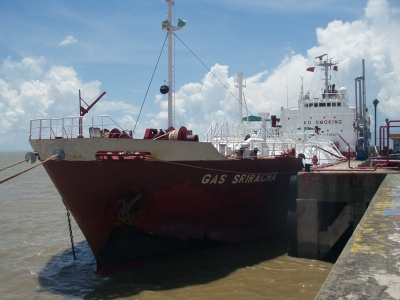
|
Gas Sriracha
3,514 cbm, built in 1996 by Uzuki Zosencho, sold
to Centaurus Transport Ltd and now renamed
'Grampian' |
It is in this sector that there has been the largest
number of transactions this year. The rise in freight
rates finally allowed sellers to find buyers for their
fleets, and for buyers to be able to justify such
investments thanks to the better economic environment.
The strong increase in newbuilding costs for this
type of carrier also played its part in reactivating
interest in second-hands, but for the moment buyers can
only count on the older units, which then logically
will push potential buyers of more modern carriers to
newbuildings.
Camillo Eitzen, who took over the Kil fleet several
years ago, has bought the fleet of his Norwegian
compatriot Igloo for about $ 75 million (7 ethylene
carriers of 8,000 to 10,000 cbm, built between 1982 and
1989). This same owner then bought the Gibson Tankers
fleet (3 carriers of 6,000 cbm built in 1982 and 2
carriers of 3,500 cbm built in 1991).
In the pressurised sector, the sale of the Japanese
owner's Far East Shipping fleet (9 carriers of 3,500
cbm built between 1996 and 2003 and two carriers of
5,000 cbm built in 1994 and 1995) to Exmar Kosan, for
about $ 85 million, caused quite a sensation at the end
of the first quarter. The reported values revealed a
price varying from $ 6 million for a carrier of 3,500
cbm built in 1996 to $ 9,5 million for one delivered in
2003 on one hand, and on the other hand a price of
around $ 7 million for carriers of 5,000 cbm. These
values show an increase of 20 % over the lowest levels
achieved for comparable ships in 2002 and 2003.
During the third quarter with freight rates reaching
more encouraging levels, the market saw the entrance of
a new name in the LPG sector, the Greek Vafias, buyer
of 9 pressurised and semi-ref LPG carriers of 1,500 to
6,500 cbm. The level of prices paid put the value for
10 years old pressurised carriers of 5,000 cbm and
3,500 cbm at respectively around $ 12 and $ 8,5
million. In the same way, the purchase of two semi-refs
of 3,500 cbm built at the beginning of the 1990s,
allowed these ships to obtain in 2004, prices above
those reached in 2000 and above all a 70 % increase
over the prices they got in 2003. As an illustration,
it is worth recalling that freight rates for a 12-month
period has been following a similar evolution: $
220,000 in 2000, $ 170,000 in 2003, and about $ 320,000
at the end of 2004.
If it maintains, the improvement in freight rates
should encourage a revival of newbuilding orders
although construction costs are higher and since the
second-hand market offers too few opportunities for the
renewal of fleets.
|
Shipping and Shipbuilding Markets in 2004
I N D E X
|